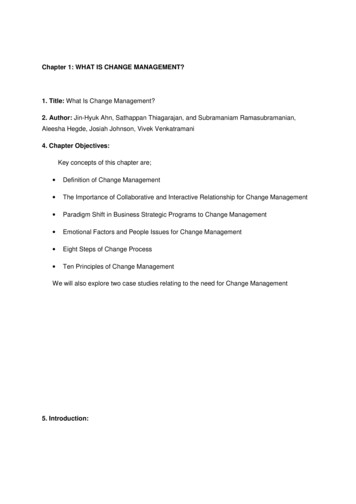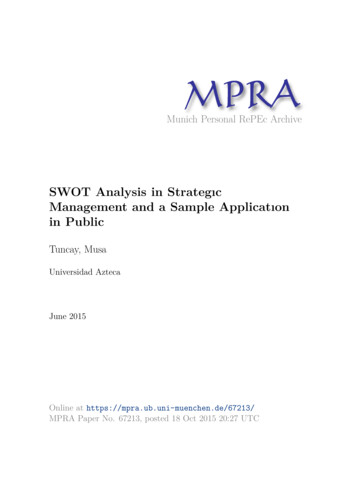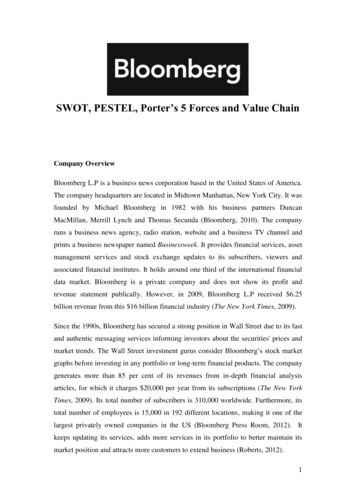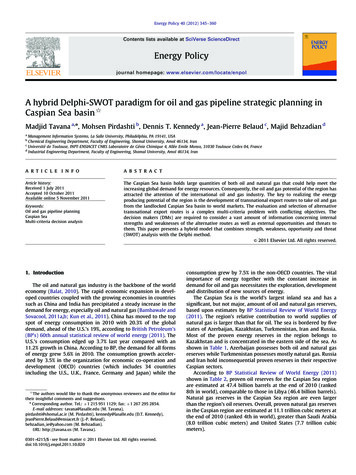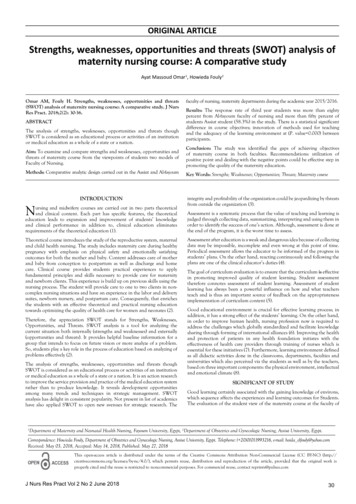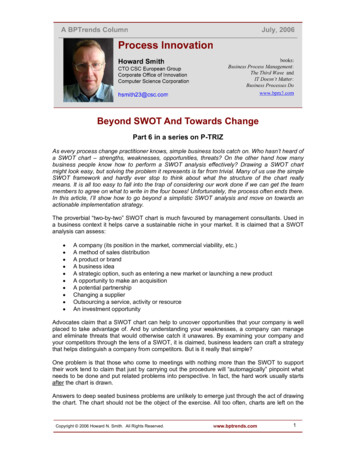
Transcription
Beyond SWOT And Towards ChangePart 6 in a series on P-TRIZAs every process change practitioner knows, simple business tools catch on. Who hasn’t heard ofa SWOT chart – strengths, weaknesses, opportunities, threats? On the other hand how manybusiness people know how to perform a SWOT analysis effectively? Drawing a SWOT chartmight look easy, but solving the problem it represents is far from trivial. Many of us use the simpleSWOT framework and hardly ever stop to think about what the structure of the chart reallymeans. It is all too easy to fall into the trap of considering our work done if we can get the teammembers to agree on what to write in the four boxes! Unfortunately, the process often ends there.In this article, I’ll show how to go beyond a simplistic SWOT analysis and move on towards anactionable implementation strategy.The proverbial “two-by-two” SWOT chart is much favoured by management consultants. Used ina business context it helps carve a sustainable niche in your market. It is claimed that a SWOTanalysis can assess: A company (its position in the market, commercial viability, etc.)A method of sales distributionA product or brandA business ideaA strategic option, such as entering a new market or launching a new productA opportunity to make an acquisitionA potential partnershipChanging a supplierOutsourcing a service, activity or resourceAn investment opportunityAdvocates claim that a SWOT chart can help to uncover opportunities that your company is wellplaced to take advantage of. And by understanding your weaknesses, a company can manageand eliminate threats that would otherwise catch it unawares. By examining your company andyour competitors through the lens of a SWOT, it is claimed, business leaders can craft a strategythat helps distinguish a company from competitors. But is it really that simple?One problem is that those who come to meetings with nothing more than the SWOT to supporttheir work tend to claim that just by carrying out the procedure will “automagically” pinpoint whatneeds to be done and put related problems into perspective. In fact, the hard work usually startsafter the chart is drawn.Answers to deep seated business problems are unlikely to emerge just through the act of drawingthe chart. The chart should not be the object of the exercise. All too often, charts are left on theCopyright 2006 Howard N. Smith. All Rights Reserved.www.bptrends.com1
shelf after meetings, with no idea of how to move forward once the pretty picture has beenagreed.Another problem with SWOT lies in its flexibility. For example: why not SWOT from theperspective of a competitor? Could this reveal how they think and provide ideas for how tocompete against them? SWOT away, you’ll end up creating a lot of charts. What do they allmean? How can we bring all these perspectives together in a single innovation model?You Need To Know The Answer BeforehandThrowing SWOT techniques into a group unfamiliar with the logic of the tool is unlikely to revealanything other than rather obvious statements. Teams normally need guidance.There is no end of advice on how to fill out a SWOT chart. Some of this is trivial. Other advice ismore sophisticated. Even the simplest of advice can help. For example, there is no point listing anopportunity (O) if the same opportunity is available to competitors. Likewise, it is futile to state youhave strengths (S) if your competitors enjoy the same benefits.Real answers don’t come easily. Many factors can debilitate a SWOT workshop. For example,there may be internal political factors preventing team members from contributing. A team unableto communicate its strengths over the competition is embarrassing.Intelligent use the SWOT tool requires training and experience. Because teams find it hard towork and think along structured lines, “facilitators” are often employed in workshops. They employmany aids to creativity. If they encounter mental blocks in the team, blank stares or other forms ofpsychological inertia, a good facilitator will introduce check lists in order to prompt thinking. Thebest facilitators come pre-armed with targeted and relevant checklist items. They will know whento throw check list items into the conversation. For example, when considering threats (T), atrained facilitator will prompt the team to think about: Political effectsLegislative effectsEnvironmental effectsIT developmentsCompetitor intentions - variousMarket demandNew technologies, services, ideasVital contracts and partnersSustaining internal capabilitiesObstacles facedInsurmountable weaknessesLoss of key staffSustainable financial backingEconomy - home, abroadSeasonality, weather effectsLists such as these are no doubt helpful as memory aids. Yet beyond prompting, neither thefacilitator nor the chart itself can provide any answers. The content must come from the team.Every SWOT Is A ProblemHave you ever thought about what a SWOT chart really is? It is more just four boxes on a page.Each box relates to the other. When developing a SWOT you are developing a statement about aproblem. Think about it. Opportunities are problems. The problem is how to exploit thoseopportunities. Weaknesses are also problems. They must be overcome lest they prevent youCopyright 2006 Howard N. Smith. All Rights Reserved.www.bptrends.com2
exploiting your strengths in the pursuit of the opportunities. Threats are problems, which couldjeopardize capitalizing on strengths. Every SWOT chart is a conundrum and this is why manySWOT charts sit on shelves with the problem unsolved. Rarely if ever does a company develop acomprehensive strategy for dealing with the outcome of a SWOT workshop.Systematic innovation and problem-solving processes like P-TRIZ can move us beyond the basicSWOT to provide a comprehensive approach to mobilizing a strategy for action. To get fromSWOT to process change requires a comprehensive process.What A SWOT Really IsIf a SWOT is a problem, then the elements of the SWOT are the factors that combine to createthe knot that the company wishes to solve. Here is one TRIZ model of a SWOT:Figure 1 – A TRIZ model of a SWOT chartThe model says: Strengths counteract weaknesses and also create opportunities. Weaknessescounteract opportunities and also create threats. In turn, threats counteract opportunities.Now that we understand what a SWOT really is, TRIZ is able to use the model to generatestrategies for solving the problem:1. Find an alternative way to obtain [the] (Strengths) that offers the following: provides orenhances [the] (Opportunities), eliminates, reduces, or prevents [the] (Weaknesses).2. Find a way to eliminate, reduce, or prevent [the] (Weaknesses) in order to avoid [the](Threats).3. Find an alternative way to obtain [the] (Opportunities) that offers the following: does notrequire [the] (Strengths), is not influenced by [the] (Weaknesses) and (Threats).4. Find a way to protect [the] (Opportunities) from the harmful influence of [the] (Weaknesses)and (Threats).5. Consider replacing the entire system with an alternative one that will provide [the](Opportunities).6. Find a way to eliminate, reduce, or prevent [the] (Threats) under the conditions of [the](Weaknesses).Etc.Read each in turn and you’ll see that they are indeed distinctive ways of tackling the problem.TRIZ can also generate useful compromise solutions, such as:Copyright 2006 Howard N. Smith. All Rights Reserved.www.bptrends.com3
1.1. Find a way to increase the effectiveness of [the] (Strengths).1.2. Find additional benefits from [the] (Strengths).1.3. Find a way to obtain [the] (Opportunities) without the use of [the] (Strengths).1.4. Try to increase the effectiveness of the action of [the] (Strengths) toward reducing theharmful nature of [the] (Weaknesses).1.5. Consider modifying or influencing [the] (Weaknesses) to improve its being eliminated,reduced, or prevented by [the] (Strengths).2.1. Find a way to benefit from [the] (Weaknesses).2.2. Find a way to decrease the ability of [the] (Weaknesses) to cause [the] (Threats).3.1. Find a way to increase the effectiveness of [the] (Opportunities).3.2. Find additional benefits from [the] (Opportunities).4.1. Try to compensate for the harmful influence of [the] (Weaknesses) and (Threats) towards[the] (Opportunities).4.2. Try to reduce the sensitivity of [the] (Opportunities) to the harmful influence of [the](Weaknesses) and (Threats).5.1. Consider transition to the next generation of the system that provides [the](Opportunities), but which will not have the existing problem.5.2. Consider enhancing the current means by which the primary useful function is achieved,to the extent that the benefits will override the primary problem.5.3. Consider giving up the primary useful function to avoid the primary problem.6.1. Find a way to benefit from [the] (Threats).In P-TRIZ, each of these problem-solving directions is associated with problem-solving strategies.For example, in response to “1.2 Find additional benefits from [the] (strengths)” TRIZ will suggestthe following:“Most existing systems carry some amount of redundancy – that is, they possess unutilizedresources. As a result, a system created to perform a certain function can perform additionalfunctions as well. For example, the airflow from a vacuum cleaner can be used to deodorizeand/or disinfect the air. Similarly, a vacuum cleaner can be used to catch flies and other insects.To find ways that an existing system or system element might be utilized for some additionalpurpose, consider the following: Identify the currently-implemented function(s) of a system or system elementSpecify the action(s) currently performed by the systemSpecify the components responsible for performing these actionsIdentify the component properties that allow these actions to be performedThink of other ways that these actions and/or properties might be utilized”TRIZ goes beyond the pre-prepared lists of SWOT facilitators. The directions generated by TRIZare a powerful stimulus to creativity and solution development.Copyright 2006 Howard N. Smith. All Rights Reserved.www.bptrends.com4
TRIZ For SWOTThe problem with every SWOT chart is that the relationships of the strengths, weaknesses,opportunities, and threats are rarely identified.Let’s take an example of a business-to-business manufacturing company.The company has, in the past, relied on distributors to take its products to the end users. Theopportunity, and therefore the subject of SWOT analysis, is for the company to build its owndistribution network for certain market segments. Here is the SWOT the team developed for thisproblem:Strengths End-user sales control and direction Right products, quality and reliability Superior product performance versuscompetitors Better product life and durability Spare manufacturing capacity Some staff have experience of enduser sector Have customer lists Direct delivery capability Product innovations ongoing Can serve from existing sites Products have requiredaccreditations Processes and IT should cope Management is committed andconfidentOpportunities Could develop new products Local competitors have poorproducts Profit margins will be good End-users respond to new ideas Could extend to overseas New specialist applications Can surprise competitors Support core business economies Could seek better supplier dealsWeaknesses Customer lists not tested Some gaps in range for certainsectors We would be a small player No direct marketing experience We cannot supply end-users abroad Need more sales people Limited budget No pilot or trial done yet Don't have a detailed plan yet Delivery-staff need training Customer service staff need training Processes and systems, etc Management cover insufficientThreats Legislation could impact Environmental effects would favorlarger competitors Existing core business distributionrisk Market demand very seasonal Retention of key staff critical Could distract from core business Possible negative publicity Vulnerable to reactive attack bymajor competitorsTable 1 – Example of a SWOT chartNo doubt the checklists used by the facilitator helped in developing this chart. Yet the chart has aproblem, a problem common to all such charts. It is difficult to see what to do next. There arebetween ten to twenty items listed under each heading. How do they impact one another? Weknow that weaknesses counteract strengths and opportunities, but in a standard chart, each ofthe strengths, and each of the weaknesses are lumped together in the two-by-two matrix. Thismakes it impossible to see the wood for the trees. We simply have no idea, from the SWOT itself,for how to move forward. For example, one of the strengths listed is ‘Some staff have experienceCopyright 2006 Howard N. Smith. All Rights Reserved.www.bptrends.com5
of end-user sector.’ How exactly does that help? It clearly has some relationship to other items inthe chart, for example:‘Staff with experience of end-user sector’ may be able to counteract some of the weaknessesidentified, such as ‘customers lists not tested’ and a ‘need for more sales people’. Perhaps thereare other connections. Could it be that the ‘staff with experience of the end-user sector’ couldtrain the ‘delivery staff’ noted as a weakness?The same principle can be extended to look at other dimensions of the problem. Could the ‘staffwith end-user experience’ help in the innovation process to ‘develop products for this sector,’which is one of the opportunities listed? Could they provide information to manage the ‘seasonalvariations’ noted as a threat? The problem is complex and the number of permutations is large.Each of the entries in the two-by-two matrix could impact any of the other entries. Herein is themain weakness of a SWOT. The chart gives no insight into relationships between factors in theenvironment that give rise to the opportunities, and which, if not solved, will limit
In this article, I’ll show how to go beyond a simplistic SWOT analysis and move on towards an actionable implementation strategy. The proverbial “two-by-two” SWOT chart is much favoured by management consultants. Used in a business context it helps carve a sustainable niche in your market. It is claimed that a SWOT analysis can assess: A company (its position in the market, commercial

